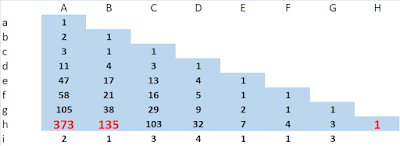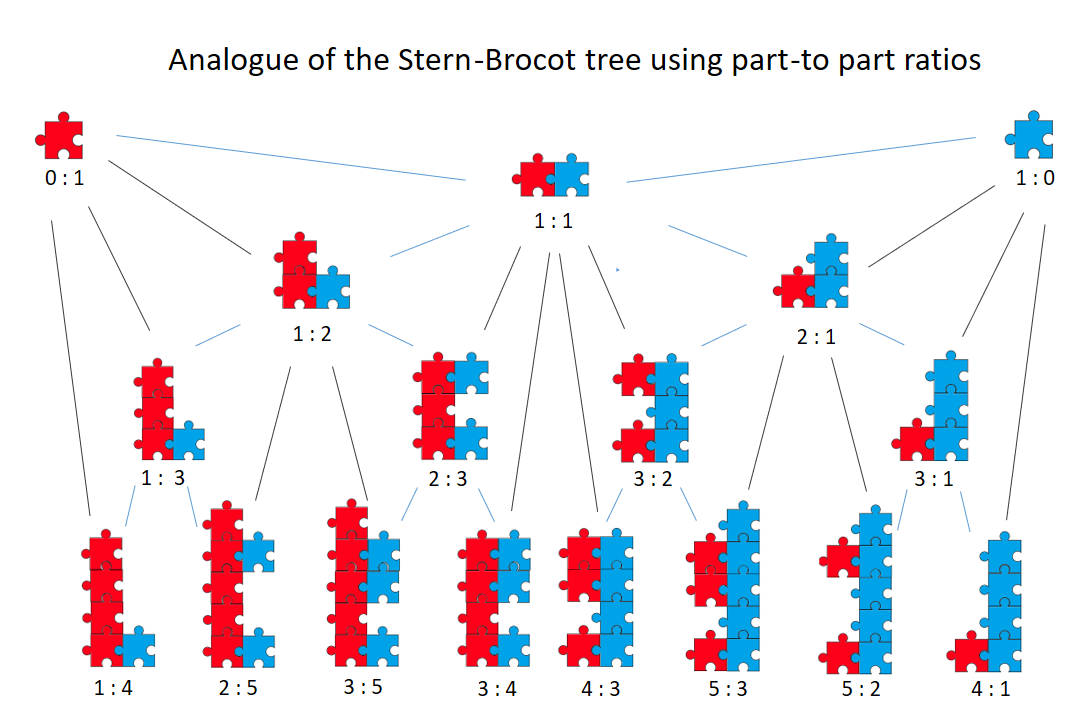Continued Fraction Triangle
This post is about patterns in the calculation of a continued fraction and its reverse and in successive
truncations of a continued fraction.
Table 1: calculation of continued fraction (row i) from integers 373 and 135 (row h) and calculation of convergents by successively truncating the continued fraction (upwards, rows g to a). Column H row h is the greatest common divisor of 373 and 135.
DESCRIPTION OF TABLES 1 AND 2
Table 1 is a calculation of continued fraction (row i) from integers 373 and 135 (row h) and calculation of convergents by successively truncating the continued fraction by one term at a time (working upwards, rows g to a). Column H row i is the greatest common divisor of 373 and 135. The continued fraction can be interpreted as either [2; 1, 3, 4, 1, 1, 3], which represents \( \frac{373}{135} \) or [0; 2, 1, 3, 4, 1, 1, 3], which is the inverse \( \frac{135}{373} \).
Row g of Table 1 calculates the same continued fraction but without its final term. The resulting integers (105 and 38) represent the co-efficients of a Bézout identity for 373 and 135. That is to say: 38 x 373 - 105 x 135 = |1|. Each two-by-two array within the blue highlighted triangle also cross-multiplies to |1|. Columns A and B contain successive convergents to the fraction created by 373 and 135. The reason for this is discussed below.
Table 2 begins in row i with the reversal of the continued fraction from Table 1. Table 2 is completed by successive truncation of the reversed continued fraction. The number 373 appears in the same place in Tables 1 and 2, representing the fact that the numerator of a continued fraction is the same as the numerator of its reversal. As in Table 1, each two-by-two array within the blue highlighted triange cross-multiplies to 1.
The blue-highlighted sections of Tables 1 and 2 are mirror images of each other, the line of reflection being the upward sloping diagonal from column A row h to column D row d containing the numbers 373, 38, 16 and 4.
Rows i and h are calculated from the chosen integers 373 and 105 in Table 1 and Table 2 above as follows:
|
Euclidean
algorithm |
A = k B +
r |
B = k1 r + r1 |
r = k2 r1
+ r2 |
r1 = k3
r2 + g |
r2 = k4g
+ 0 |
gcd (A,B) =
g |
|
Continued
fraction |
k |
k1 |
k2 |
k3 |
k4 |
|
Calculation of continued fraction truncated at penultimate term (right to left) | k k1k2 k3 + | k1k2 k3 + | k2 k3 + 1 | k3 | 1 |
|
Euclidean algorithm | A = k B + r | B = k1 r + r1 | r = k2 r1 + r2 | r1 = k3 r2 + g | r2 = k4g + 0 | gcd (A,B) = g |
Continued fraction denominators | k | k1 | k2 | k3 | k4 | |
Calculation of continued fraction truncated at penultimate term (right to left) | C = k k1k2 k3 + | D = k1k2 k3 + k1 + k3 | k2 k3 + 1 | k3 | 1 |
|
Calculation of continued fraction (right to left) | A = k2 k3 k4 + | B = | k2 k3 k4 + k2 + k4 | k3 k4 + 1 | k4 | gcd (A,B) = 1 |
Denominators of continued fraction | k | k1 | k2 | k3 | k4 | |
Calculation of reverse continued fraction truncated at penultimate term (right to left) | B = | D = k1k2 k3 + k3 + k1 | k1 k2 + 1 | k1 | 1 |
|
Calculation of reversed continued fraction (right to left) | A = | C = | k k1 k2 + k2 + k | k k1 + 1 | k | gcd (A, C) = 1 |
Denominators of reversed continued fraction | k4 | k3 | k2 | k1 | k | |
Calculation of continued fraction truncated at penultimate term (right to left) | a | b | c | 1 |
|
Calculation of continued fraction | d | e | f | g | 1 |
Sub-sequence of continued fraction denominators | kn-3 | kn-2 | kn-1 | kn |
|
Consider a simple continued fraction
calculated as in Table 6 and presented in an array in the top two rows
above. The bottom row contains the
denominators of the continued fraction.
It directs the calculation of the array but is not part of the array
under consideration.
First step: Show that the first 2 x 2 array on
the right of the table cross-multiplies to |1|.
Second step: Show that if some 2 x 2 array
cross-multiplies to |1|, then the next overlapping 2 x 2 array to its left also
cross-multiplies to |1|.
We can conclude that all 2 x 2 arrays in the
large array cross-multiply to |1|.
This shows that truncating the simple
continued fraction at the penultimate term will yield a Bézout identity. Successive truncations as in Tables 1 and 2 will
yield successive convergents to the original continued fraction. This is because as the continued fraction is
successively truncated upwards the resulting sub-arrays will all cross-multiply
to |1| and at
the final truncation the fraction will be unity.
First step:
By calculation of the array: c = kn-1 , g
= kn , f = g kn-1 + 1 = kn kn-1 + 1
c.g - f.1 = kn-1 kn - (kn kn-1
+ 1) = -1 = |1|
Second step:
Assume that b f - c e = |1|.
a = b kn-3 + c
d = e kn-3 + f
a e - b d = e b kn-3 +
e c - b e kn-3 - b f =
ec - bf = |1|
In the case of a greatest common divisor greater than 1, it can be shown
by a similar argument that each 2 x 2 array will cross-multiply to that
greatest common divisor.



Comments
Post a Comment